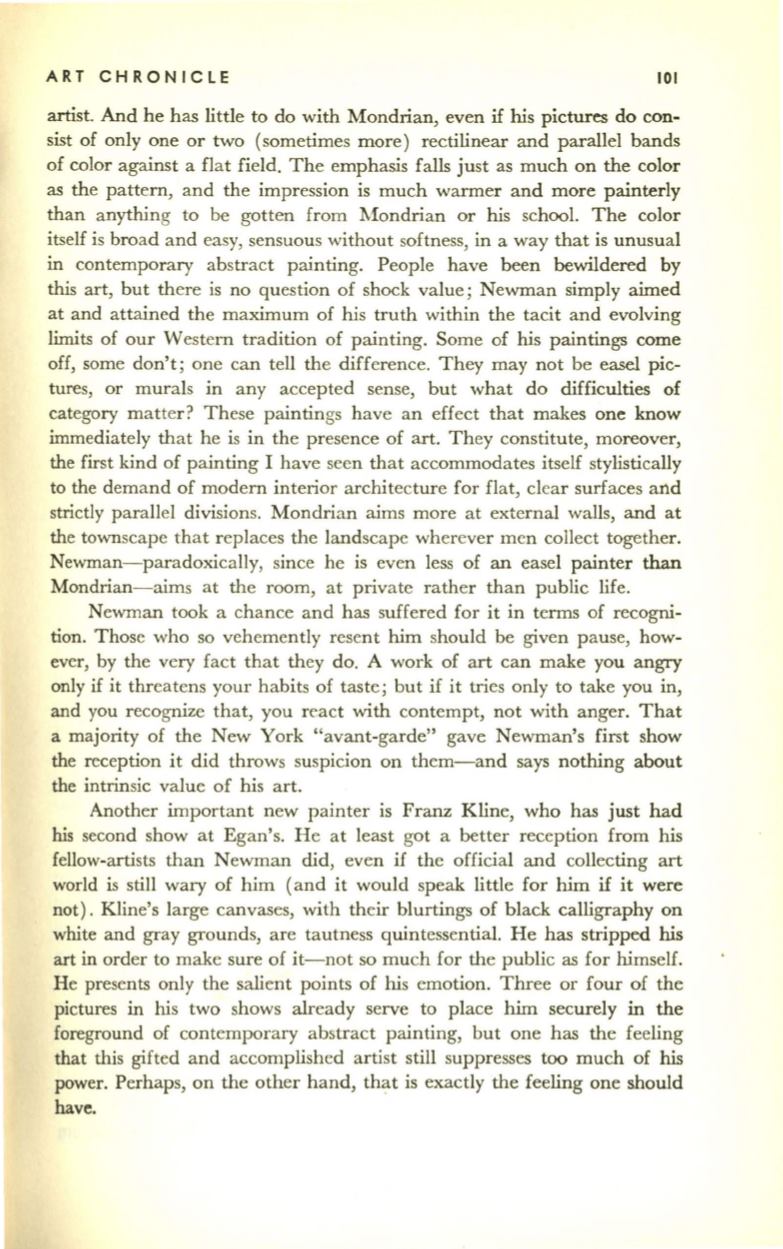
ART CHRONICLE
101
artist. And he has little to do with Mondrian, even
if
his pictures do con–
sist of only one or two (sometimes more) rectilinear and parallel bands
of color against a flat field. The emphasis falls just as much on the color
as the pattern, and the impression is much warmer and more painterly
than anything to be gotten from Mondrian or his school. The color
itself is broad and easy, sensuous without softness, in a way that is unusual
in contemporary abstract painting. People have been bewildered by
this art, but there is no question of shock value; Newman simply aimed
at and attained the maximum of his truth within the tacit and evolving
limits of our Western tradition of painting. Some of his paintings come
off, some don't; one can tell the difference. They may not be easel pic–
tures, or murals in any accepted sense, but what do difficulties of
category matter? These paintings have an effect that makes one know
immediately that he is in the presence of art. They constitute, moreover,
the first kind of painting I have seen that accommodates itself stylistically
to the demand of modem interior architecture for flat, clear surfaces and
strictly parallel divisions. Mondrian aims more at external walls, and at
the townscape that replaces the landscape wherever men collect together.
Newman-paradoxically, since he is even less of an easel painter than
Mondrian-aims at the room, at private rather than public life.
Newman took a chance and has suffered for it in terms of recogni–
tion. Those who so vehemently resent him should be given pause, how–
ever, by the very fact that they do. A work of
art
can make you angry
only if it threatens your habits of taste; but if it tries only to take you in,
and you recognize that, you react with contempt, not with anger. That
a majority of the New York "avant-garde" gave Newman's first show
the reception it did throws suspicion on them-and says nothing about
the intrinsic value of his art.
Another important new painter is Franz Kline, who has just had
his second show at Egan's. H e at least got a better reception from his
fellow-artists than Newman did, even if the official and collecting art
world is still wary of him (and it would speak little for him if it were
not). Kline's large canvases, with their blurtings of black calligraphy on
white and gray grounds, are tautness quintessential. He has stripped his
art
in order to make sure of it-not so much for the public as for himself.
He presents only the salient points of his emotion. Three or four of the
pictures in his two shows already serve to place
him
securely in the
foreground of contemporary abstract painting, but one has the feeling
that this gifted and accomplished artist still suppresses too much of
his
power. Perhaps, on the other hand, that is exactly the feeling one should
have.


